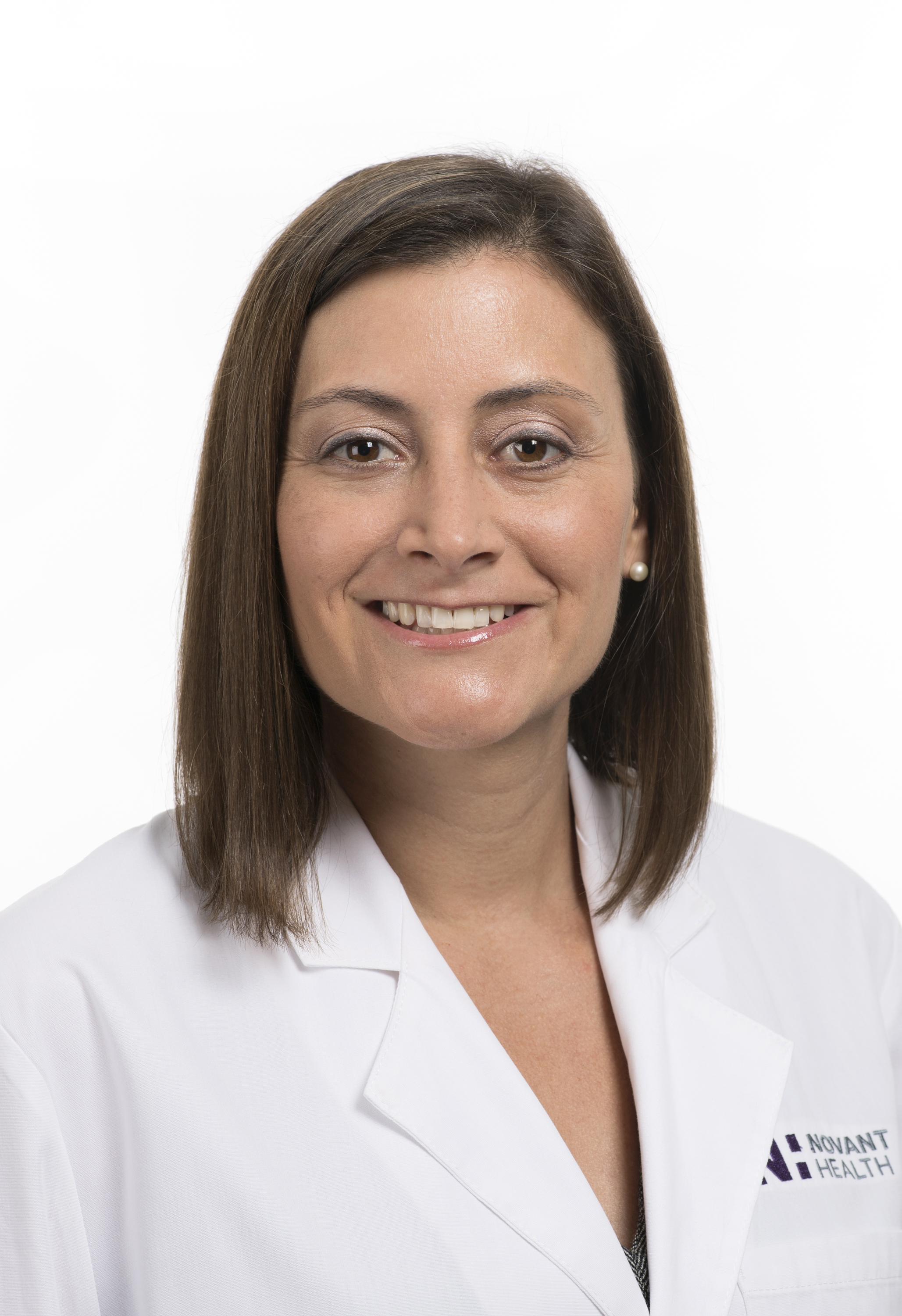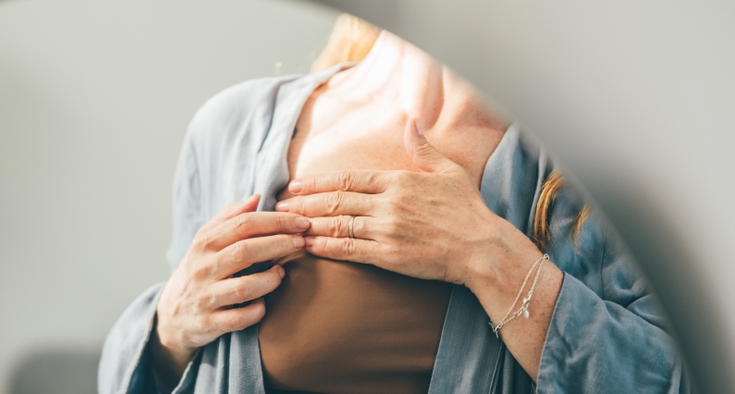
If you habitually check your breasts for lumps quadrant-by-quadrant on the same day of each month, breast surgical oncologist Dr. Lori Gentile of Novant Health Cancer Institute - Elizabeth gives you gold stars. But if you don’t? No lecture today.
It’s important to watch your breasts for changes, but a formal monthly self-exam is no longer recommended. Instead, most major medical groups now encourage “breast self-awareness.”
We spoke with Gentile about what it means to be breast self-aware, why the recommendations about breast self-exams have changed and what to do if you detect something concerning.
Mammograms save lives. Book yours today.
What is breast self-awareness?
It means knowing what’s normal for your own breasts — what they look and feel like, so if there are any changes, you can notice and report them to your doctor or other clinician.
How is this different than previous recommendations?
Doctors used to recommend a step-by-step monthly routine for checking your breasts. Now, we say there’s no regimented, special way or time that you need to check your breasts. (See the reason for the change in recommendations below.)
Instead, we encourage overall awareness: not just feeling for lumps, but noticing any changes. If you feel or see something different or concerning, get evaluated.
Break this down for me. What should I actually do to be breast self-aware?
Get familiar with your own breasts by checking them regularly and noticing how they change over time.
Look at your breasts in the mirror with your arms at your sides and then raised. Feel your breasts from time to time, such as when showering, dressing or lying down.
What am I looking and feeling for?
First, just get used to how your breasts look and feel. Breasts can vary wildly depending on a woman's weight, age, genetics and hormonal profile, so it's important to be aware of what’s normal for you.
You may have variations in the texture of the breast — that’s normal. You may feel areas of prominent dense tissue and cysts — “lumpiness” may be a normal and healthy baseline for your breasts. Past surgeries can also lead to the development of scar tissue that may feel lumpy and bumpy. Familiarize yourself with the texture of your breasts.
And look for changes. You may feel changes to your breasts as you lose and gain weight. In younger women, your breasts may change with your monthly cycle. Breastfeeding can also change the size, shape and way the breasts feel multiple times per day.
The key is to recognize the normal patterns for your breasts and pay attention to any changes that you haven’t seen before.
Look for a new lump or mass in the breast or underarm, or significant changes in the size, shape or appearance of the breast. Changes to the nipple like “flattening” or “pulling in” or nipple discharge — especially if it’s bloody — should register as a concern. Pain in one area of the breast that doesn’t go away, and skin changes such as redness, dryness, dimpling or puckering should also raise red flags.
What should I do if I notice something new or concerning?
Call your established internal medicine or family medicine provider or your ob-gyn. If you don’t have an established clinician, this is a good reason to start a relationship with one. Be specific with the scheduler about why you’re calling. Some doctors may want you to get imaging done before your appointment.
When we see these types of skin changes on the outside, doctors usually want to look on the inside. To do so, your provider may send you to a breast center for imaging. If your provider is concerned about your imaging or something they saw or felt during their clinical exam, they’ll usually send you to a breast specialist.
Although 80% of breast lumps are benign, you should always be checked out by a doctor.
Why did the recommendation about monthly breast self-exams change?
That recommendation was based on the idea that teaching average-risk women to do regular breast self-exams would reduce the number of deaths from breast cancer.
However, multiple large studies found no reduction in deaths. Some studies also showed pitfalls: Breast self-exams can lead to unnecessary procedures and tests, meaning extra anxiety, costs and potential medical complications for some women. Breast self-exams may also give a false sense of security: Some women may be less likely to get a yearly mammogram because their breasts feel normal.
Can I still do a monthly breast self-exam if I want to?
Absolutely — regular systematic breast checks are still OK. It's a great habit to get into, and in my opinion, leads to excellent breast self-awareness. Smaller observational studies have suggested that women who perform breast self-exams may detect tumors earlier.
But if you weren’t doing breast self-exams, don’t knock yourself. The push is now to simply be aware of your normal and assess yourself regularly for changes. It doesn’t have to be done a single certain way.
What’s more important: mammograms, yearly clinical exams or breast self-awareness?
They are all important tools that, layered on top of each other, can help you find cancer early.
For most women younger than 40 years old, breast self-awareness and getting a yearly clinical breast exam by your primary care provider or ob-gyn will be your best tools to detect breast cancer.
If you are 40 or older, add a yearly mammogram too. Mammograms show cancer earlier than you can feel it. On average, cancers detected by an annual mammogram are 1/8 inch in size compared to 1/2 to 1 inch or larger in women who do occasional or regular breast self-exams. Finding breast cancer earlier often means less aggressive treatment and a higher survival rate.
Mammography isn’t as good at detecting cancer early in younger women due to their hormones and the density of their breast tissue, which is why we don’t recommend them earlier than 40 years old for most women. (But based on risk factors and family history, some women start mammograms and other imaging earlier — talk to your doctor about what’s right for you.)
In my clinical experience, it’s actually unusual that women find their cancer doing routine checks — instead, often they’re like, “Oh, I randomly brushed against this,” or “I noticed a change.” They come across their warning sign in innumerable ways, and it isn’t necessarily by doing the regimented breast self-exam.
The key is to pay attention when you see it, and to reach out for help. Don’t tell yourself, “It’s nothing,” or “I don’t know what this is, so I’m going to put it off and see what happens.” If it isn’t cancer, you aren’t wasting our time — and if it is cancer, it’s always better to find out at a smaller, earlier stage.
Six lifestyle choices that lower your risk of breast cancer
- Limit or avoid alcohol.
- Reach and maintain a healthy weight for your body.
- Exercise regularly: Experts recommend 150 minutes per week of moderate intensity exercise such as walking or cycling or 75 minutes of vigorous intensity exercise such as high-intensity interval training, and strength training twice weekly.
- Avoid smoking and secondhand smoke.
- Eat a Mediterranean diet.
- Breastfeed if you have a baby.










